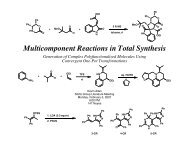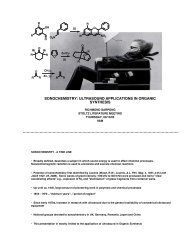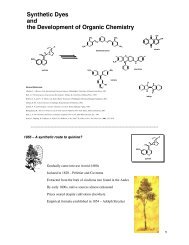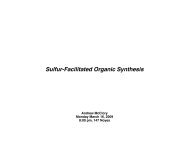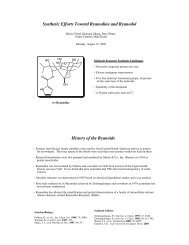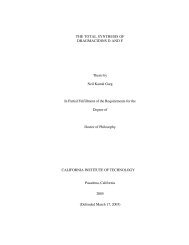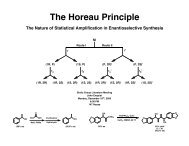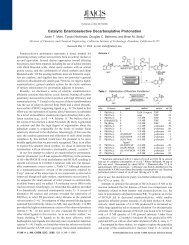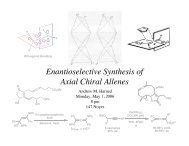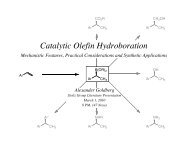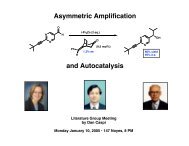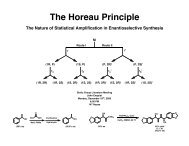Accepted Manuscript - The Stoltz Group - California Institute of ...
Accepted Manuscript - The Stoltz Group - California Institute of ...
Accepted Manuscript - The Stoltz Group - California Institute of ...
You also want an ePaper? Increase the reach of your titles
YUMPU automatically turns print PDFs into web optimized ePapers that Google loves.
ARTICLE IN PRESSC-H Bond Functionalizations with Palladium(II): IntramolecularOxidative Annulations <strong>of</strong> ArenesEric M. Ferreira, Haiming Zhang, and Brian M. <strong>Stoltz</strong>*<strong>The</strong> Arnold and Mabel Beckman Laboratories <strong>of</strong> Chemical Synthesis, Division <strong>of</strong>Chemistry and Chemical Engineering, <strong>California</strong> <strong>Institute</strong> <strong>of</strong> Technology, Pasadena, CA91125, USAAbstract: Oxidative annulations for the synthesis <strong>of</strong> carbocycles were developed using acatalytic palladium(II) system. Indoles with pendant olefin tethers were oxidativelycyclized to form annulated products. Electron-rich aromatic systems were alsoinvestigated, culminating in the synthesis <strong>of</strong> benz<strong>of</strong>urans and dihydrobenz<strong>of</strong>urans by asimilar protocol. <strong>The</strong>se reactions were demonstrated to proceed by an initial C-H bondfunctionalization event, followed by olefin insertion and β-hydride elimination.1. IntroductionPalladium(0)-catalyzed carbon-carbon bond forming reactions have been wellestablishedin synthetic chemistry. 1 Processes such as the Heck reaction, 2 Stille andSuzuki couplings, 3,4 and the Sonogashira reaction 5 have been widely used for the efficientconstruction <strong>of</strong> carbon-carbon bonds. <strong>The</strong>se transformations are all initiated by theoxidative addition <strong>of</strong> an organic halide to a palladium(0) catalyst, the byproducts <strong>of</strong> theseACCEPTED MANUSCRIPTreactions being either HX (for the Heck and Sonogashira reactions) or MX (for the crosscouplingreactions).
ARTICLE IN PRESSConversely, dehydrogenative carbon-carbon bond forming reactions catalyzed bypalladium(II) have seen relatively little use in synthetic chemistry. 6A number <strong>of</strong>oxidative transformations that can be envisioned by such a process are depicted in Figure1. <strong>The</strong>se transformations result in the functionalization <strong>of</strong> two C-H bonds and theformation <strong>of</strong> a new C-C bond. Carbons <strong>of</strong> any hybridization (sp, sp 2 , or sp 3 ) can beviewed as potential coupling partners for these dehydrogenative bond forming reactions.Figure 1. Oxidative carbon-carbon bond forming reactions.sp 2 -sp CouplingR 3R 1R 2HR 3R 1R 2HR 3R 2R 3R 1R 2HR 1HHR 5 R 3 R 5H[O] R 1R 6R 6 H 2R 4 R 2 R 4R R43[O] R R 1 5H R H 6 R 26R 5 R 2 R 4HR 4R 5R 6[O]R 4R 1R 2R 3R 4H 21 2 3sp 2 -sp 2 Coupling4 5 6sp 2 -sp 3 Coupling7 8 9sp 3 -sp 3 Coupling[O]R 1 R 4R 3 R 6R 2 R 510 11 12<strong>The</strong>se transformations, though attractive in their simplicity, represent a significantchallenge in chemical synthesis, largely due to the difficulties associated with thechemoselective functionalization <strong>of</strong> a relatively inert C-H bond. Despite this barrier, atremendous effort has been put forth over the past thirty years toward the transition metalactivation <strong>of</strong> C-H bonds. 7ACCEPTED MANUSCRIPTOne such reaction manifold is the oxidative coupling <strong>of</strong> anH 2arene and an olefin by palladium(II), pioneered by Fujiwara. 8Although successful inseveral intermolecular cases, examples <strong>of</strong> intramolecular reactions are rare. Wehypothesized that the palladium catalyzed aerobic systems we had been studying in other
ARTICLE IN PRESStransformations (i.e., kinetic resolution <strong>of</strong> secondary alcohols, 9 oxidativeheterocyclizations 10 ) could be utilized in intramolecular C-C bond forming reactionsbetween an arene and an olefin. Described herein are our efforts toward this goal,culminating in the palladium-catalyzed oxidative annulations <strong>of</strong> indoles and the syntheses<strong>of</strong> benz<strong>of</strong>uran and dihydrobenz<strong>of</strong>uran derivatives, all involving an initial C-H bondfunctionalization event. 11Scheme 1MeOMeOPd(II)NNMeMe13 14OMeOMeOOPd(II)Pd(II)MeOMeOACCEPTED MANUSCRIPTOMe15 16OMe17 18A reaction <strong>of</strong> this type is directly analogous to the intramolecular Heck reaction,wherein a halogenated arene (19) undergoes an oxidative addition reaction withpalladium(0), followed by olefin insertion and β-hydride elimination (Scheme 2). In adehydrogenative version, a C-H bond <strong>of</strong> an arene is directly functionalized bypalladium(II), leading to a similar aryl-palladium intermediate (23). <strong>The</strong> reaction thenproceeds in the same fashion as the Heck reaction. Oxidation <strong>of</strong> the palladium(0) speciesregenerates the active palladium(II) catalyst. This oxidative coupling can be consideredmore efficient, obviating the need to first install the halide functionality required for aOOHeck process.Scheme 2
ARTICLE IN PRESSIntramolecular Heck Reaction:RYYYPd 0 - HX RRPd 0XPdX19 20 21Intramolecular Oxidative (or Dehydrogenative) Heck Reaction:RYHPd II X 2- HXRYPdX- HX22 23 242. Background2.1 Palladium(II)-Catalyzed Oxidative Arene-Olefin CouplingsInitially, reports <strong>of</strong> palladium-catalyzed couplings <strong>of</strong> arenes and olefins utilizedmetal salts such as copper acetate or silver acetate as the stoichiometric reoxidant. <strong>The</strong>first aerobic palladium-catalyzed C-C bond forming reaction was reported by Shue in1971. 12 Benzene and styrene were coupled in the presence <strong>of</strong> Pd(OAc) 2 andapproximately 20 atm O 2 at 100 °C to provide stilbene. Up to 11 catalytic turnovers wereobserved under these conditions. More recently, Jacobs has described a similar system inthe oxidative coupling <strong>of</strong> benzene derivatives and activated esters (Scheme 3). 13 In thepresence <strong>of</strong> Pd(OAc) 2 and a cocatalytic amount <strong>of</strong> benzoic acid under approximately 8atm O 2 , benzene derivatives could be oxidatively coupled to afford styrenyl compounds.Under these conditions, the turnover number and turnover frequency <strong>of</strong> the catalyst couldreach remarkably high values (762 and 73 h -1 , respectively).Scheme 3ACCEPTED MANUSCRIPTPd(OAc) 2 (1 mol%)OPhCO 2 H (20 mol%)MeOPhOEt8 atm O 2 , 90 °CRYPd 0[O]Pd II X 224 25PhOMeOOEt98% conversion(32:15:53 ortho/meta/para)26
ARTICLE IN PRESSOxidative C-C bond forming reactions using oxygen as the sole stoichiometricoxidant almost exclusively involved intermolecular examples wherein a solution <strong>of</strong> anactivated olefin (e.g., acrylate esters) in neat arene was stirred under high pressures <strong>of</strong>oxygen. One notable exception was reported by Åkermark in 1999 (Scheme 4). 14Arylaminoquinone 27 was oxidatively cyclized under catalytic Pd(OAc) 2 and 1 atm O 2 inAcOH at 95 °C to afford product 28, resembling the core structures <strong>of</strong> a number <strong>of</strong>natural products (e.g., murrayaquinone A and pyrayaquinone A).Scheme 4OONH27OOOMeNH285 mol% Pd(OAc) 2AcOH, 1 atm O 2 , 95 °C, 48 h89% yieldPalladium-mediated oxidative coupling reactions involving the indole nucleushave been studied extensively by Itahara and coworkers. 15 Catalytic examples, however,were consistently plagued by low yields (Scheme 5). N-2,6-Dichlorobenzoylindole (29)was oxidatively coupled with methyl acrylate by catalytic Pd(OAc) 2 and a number <strong>of</strong>stoichiometric oxidants (e.g., AgOAc, Cu(OAc) 2 , Na 2 S 2 O 8 , and NaNO 2 ), 15aOMebut the yieldACCEPTED MANUSCRIPTnever exceeded 20% in these systems. Alternatively, the oxidative coupling <strong>of</strong> N-tosylindole (31) was examined, in this case with higher catalyst loadings. 15bAlthoughthe yields were marginally improved (up to 42%), they were still not particularly usefulsynthetically. Fujiwara recently described a single example <strong>of</strong> a catalytic intermolecular
ARTICLE IN PRESSoxidative coupling using the indole nucleus. 16 Under Pd(OAc) 2 and abenzoquinone/TBHP reoxidation system, indole (33) was coupled to methyl acrylate toprovide 34 in 52% yield.Scheme 5ON29ClCl2 mol% Pd(OAc) 23 equiv methyl acrylate1-2 equiv reoxidantAcOH, air, 110 °CCO 2 Et10 mol% Pd(OAc) 23 equiv ethyl acrylate2 equiv reoxidantAcOH, air, 110 °CNTs NTs31 32NHO30N0.5 mol% Pd(OAc) 25 mol% benzoquinone1 equiv methyl acrylate1.3 equiv TBHPAc 2 O/AcOH, 50 °C52% yieldClClCO 2 MeReoxidant TON Yield (%)stoich. -- 25Pd(OAc) 2AgOAc 8.8 18Cu(OAc) 2Na 2 S 2 O 8NaNO 2Reoxidant TON Yield (%)stoich. -- 48Pd(OAc) 2AgOAc 3.2 31Cu(OAc) 2Na 2 S 2 O 8NaNO 2ACCEPTED MANUSCRIPTNH33 342.2 Synthetic Importance <strong>of</strong> Annulated IndolesAlthough some success has been achieved in oxidative couplings involving theindole nucleus, intramolecular catalytic examples had never been reported when webegan our work in this area in 2003. 17 In a general reaction scheme, indole 35 wouldcyclize onto a tethered olefin to afford annulated indole 36 (Scheme 6). A reaction <strong>of</strong>this type would be highly useful to the synthetic community. Several biologically activenatural products (e.g., paxilline, 18 penitrem A, 19 and yuehchukene 20 ) containing the coreCO 2 Me5.23.23.44.14.21.61067414216annulated indole structural motif could be potentially accessed by such a reaction.
ARTICLE IN PRESSScheme 6R'''NHHOHPaxilline (37)OOPd(II)R''R'O 2N R'R''NRR35 36OHHClOOHNHHOHPenitrem A (38)ACCEPTED MANUSCRIPTOOH HR'''HNHHHYuehchukene (39)We were not the first to recognize the potential utility <strong>of</strong> an intramolecular indoleannulation in natural product synthesis. In 1978, Trost reported the palladium-mediatedcyclization and subsequent reduction <strong>of</strong> indole 40 to produce (+)-ibogamine. 21,22NHFifteenyears later, Williams described the total synthesis <strong>of</strong> paraherquamide B using a similarpalladium(II)-promoted cyclization/reduction sequence <strong>of</strong> indole 42 as the keytransformation. 23More recently, Corey has reported the oxidative cyclization <strong>of</strong> indole45 using palladium(II) in the syntheses <strong>of</strong> members <strong>of</strong> the austamide class <strong>of</strong> naturalproducts. 24,25Although the cyclizations were all effective in the synthetic context, theyall required stoichiometric amounts <strong>of</strong> palladium(II) salts. By comparison, the catalyticpalladium/pyridine/O 2 system we had been studying had proven quite effective in anumber <strong>of</strong> oxidative transformations. We therefore sought to extend this system tocatalytic C-C bond forming reactions, specifically oxidative indole annulations. 26,27
ARTICLE IN PRESSScheme 7Trost 20Williams 22TBSOOONHNEtPd(CH 3 CN) 2 Cl 2AgBF 4 , Et 3 Nthen NaBH 440-45% yieldTBSOBOCN1.2 equiv PdCl 2O2 equiv AgBF 4OMe then NaBH 4ON63-80% yieldNO42 43OO HNOOMeNNO(+)-Paraherquamide B (44)Corey 23 FmocN1 equiv Pd(OAc) 2MeO 2 C HAcOH/H 2 O/THF1 atm O 2N O29% yield3. Results and Discussion3.1 Reaction Development40ACCEPTED MANUSCRIPTNHN(+)-Ibogamine (41)MeO 2 CNHNH45 46FmocNNEtBOCONONH NOO HandNONHNH(+)-Deoxyisoaustamide (47) (+)-Austamide (48)As an initial test <strong>of</strong> the viability <strong>of</strong> a catalytic oxidative indole annulation, indole13 was treated with 10 mol% Pd(OAc) 2 and 40 mol% pyridine under 1 atm O 2 in tolueneat 80 °C (Scheme 8). 28 Gratifyingly, oxidative cyclization to annulated indole 14OHOHNNOoccurred; the overall reactivity, however, was noticeably sluggish (23% conversion after12 h) relative to the other oxidative processes we had studied thus far (i.e., alcohol
ARTICLE IN PRESSoxidation 9 and various heterocyclizations 10 ). It was hypothesized that the catalyst centerwas not sufficiently electron-deficient for substrate activation. By increasing theelectrophilicity <strong>of</strong> the catalyst, potentially higher reaction rates could be achieved.Scheme 810 mol% Pd(OAc) 240 mol% pyridineToluene (0.1 M), 1 atm O 2N80 °C, 12 hNMeMe23% conversion13 14To that end, we surveyed a range <strong>of</strong> electronically differentiated pyridine ligandswith Pd(OAc) 2 (Table 1). Interestingly, there was a noticeable correlation between theelectronic nature <strong>of</strong> the ligand (estimated by the measured pK a <strong>of</strong> their respectivepyridinium ions) 29 and the overall reactivity. More electron-rich pyridine ligands shutdown the reaction (entries 1 and 2), while switching to pyridines substituted withelectron-withdrawing groups effected an increase in the reactivity, peaking with ethylnicotinate (entry 5). Further increasing the electron-deficiency, however, was detrimentalto the overall reaction (entries 6-9). <strong>The</strong>se ligands are likely unable to sufficientlycoordinate to the palladium center, hampering the catalyst’s reactivity and/orpalladium(0) reoxidation. Because ethyl nicotinate appeared to strike the appropriateelectronic balance for overall reactivity, it was selected as the ligand for further studies.Table 1. Examination <strong>of</strong> electronic effects <strong>of</strong> the pyridyl ligand.ACCEPTED MANUSCRIPT
ARTICLE IN PRESS10 mol % Pd(OAc) 240 mol % pyridine ligandentry123456789Ntoluene (0.1 M), 1 atm O 2 ,NMe80 °C, 12 hMe13 14pyridine ligand pK a (PyrH + ) a conversion (%) b4-MeO4-t-Buunsubstituted4-CO 2 Et3-CO 2 Et3-COCH 33-F3-CN3,5-di-Cl6.475.995.253.453.353.182.971.390.903123527658645522a Reference 29. b % conversion measured by GCrelative to an internal standard.With the optimal ligand in hand, other parameters in the oxidative cyclization <strong>of</strong>indole 13 were investigated. <strong>The</strong> choice <strong>of</strong> palladium(II) salt was found to be important;Pd(OAc) 2 was more effective than Pd(TFA) 2 , in contrast to the heterocyclizationchemistry. 10PdCl 2 and other palladium(II) halides were completely unreactive. <strong>The</strong>most significant effects on the reaction outcome were determined by the solvent (Table2). Moving from nonpolar aromatic solvents (entries 1-3) to more polar solventsmoderately increased the reactivity and overall yield <strong>of</strong> annulated indole 14. 30<strong>The</strong>re wasstill a noticeable discrepancy, however, between the conversion <strong>of</strong> 13 and the overallyield <strong>of</strong> 14. 31At this point, the combined yield <strong>of</strong> 13 and 14 (starting material andproduct) was observed to decrease in a nonlinear fashion over time. One possiblerationalization <strong>of</strong> this observation is that the product decomposes over the course <strong>of</strong> thereaction. 32Interestingly, this problem could be minimized by the addition <strong>of</strong> AcOH as acosolvent (entries 10 and 11). Ultimately, we found that employing a 4:1 mixture <strong>of</strong> t-ACCEPTED MANUSCRIPTamyl alcohol and AcOH as the solvent resulted in an 82% isolated yield <strong>of</strong> annulatedindole 14.Table 2. Solvent effects in the indole annulation.
ARTICLE IN PRESS10 mol % Pd(OAc) 240 mol % ethyl nicotinateentry1234567891011Nsolvent (0.1 M), 1 atm O 2NMe80 °C, 24 hMe13 14solventconversion (%) a % yield atoluenexyleneschlorobenzenedioxanediglymebutyl acetate888885879995333140423749t-amyl alcohol 9453pinacolone 9558AcOH 86 25pinacolone/AcOH (4:1) 9176t-amyl alcohol/AcOH (4:1) 99 82 ba % conversion and % yield measured by GC relative toan internal standard. b Isolated yield.3.2 Susceptibility <strong>of</strong> Annulated Indoles to OxygenThis difficulty with product decomposition was somewhat anticipated consideringprevious reports on reactions <strong>of</strong> 2,3-disbustituted indoles with oxygen. 33In 1951, Witkopdescribed the autoxidation <strong>of</strong> indoles with fused rings attached to the C-2 and C-3positions (49, Scheme 9). 34Under an oxygen atmosphere with or without reducedplatinum oxide, the indoles were converted to intermediate peroxides by addition at theC-3 position, which upon workup afford keto lactams (51). More recently, the oxidation<strong>of</strong> reserpine (52), which contains an annulated indole core, under an atmosphere <strong>of</strong>oxygen was investigated by Awang (Scheme 9). 35Two products were observed,peroxide 53 and dioxyreserpine (54), that arose from reaction with oxygen at ambienttemperature.Scheme 9ACCEPTED MANUSCRIPT
ARTICLE IN PRESS3NH2nO 2with orwithout PtHOO49 50NnHOHN51OnMeON HHNHMeO 2 CHReserpine (52)OOOMeOMeOMeOMeairMeOMeOACCEPTED MANUSCRIPTHOOHNNNHHMeO 2 CNOHOHHOMeOCOArOCOArOMeHCO 2 Me<strong>The</strong> product decomposition <strong>of</strong> our oxidative indole cyclization was probed inmore detail (Figure 2). Annulated indole 14 was subjected to the reaction conditions for24 h, and the decomposition was monitored by GC analysis relative to an internalstandard (tridecane). 36 A slight increase in product stability was observed in t-amylalcohol versus toluene, consistent with our observations <strong>of</strong> the cyclization reaction.Addition <strong>of</strong> the catalyst (10 mol% Pd(OAc) 2 , 40 mol% ethyl nicotinate) had a remarkableimpact, limiting product decomposition to approximately 30% over 24 h. <strong>The</strong> stabilitywas improved further by addition <strong>of</strong> AcOH as a cosolvent. <strong>The</strong> reasons behind thebeneficial nature <strong>of</strong> the catalyst and AcOH toward the suppression <strong>of</strong> oxidativedecomposition are currently unclear. One potential explanation is that since oxidativedecomposition is initiated by nucleophilic addition <strong>of</strong> indole into dioxygen, theelectrophilic palladium center may act as a competitive inhibitor via palladation at C-3.AcOH could act either as a second competitive inhibitor via association at C-3 or as an5354ionizing agent for L n Pd(OAc) 2 , protonating <strong>of</strong>f an acetate ligand to afford a more reactivecationic palladium(II) center. 37
ARTICLE IN PRESSFigure 2. Oxidative decomposition studies <strong>of</strong> indole 14.1009080706050403020103.3 Substrate Scope3NMewith or without10 mol % Pd(OAc) 240 mol % ethyl nicotinate0.1M solvent, 1 atm O 2 ,80 °C, 24 h14 14Decomposition <strong>of</strong> 14ACCEPTED MANUSCRIPTNMe00 5 10 15 20 25time (h)oxidativedecompositionandoligomerizationt-amyl alcohol/AcOHwith Pd catalystt-amyl alcohol with Pdcatalystt-amyl alcohol withoutcatalysttoluene withoutcatalystWith this optimized system now in hand, the substrate scope was investigated. Asshown in Table 3, good to excellent yields can be obtained across a range <strong>of</strong> substitutedindoles. Indoles substituted with electron-withdrawing or electron-donating groups onthe arene cyclize efficiently (entries 4 and 5). Substitution on the tether α to the olefinresulted in a diastereoselective cyclization (entry 8), whereas substitution at the C-3α siteimparted no diastereoselectivity (entry 9). Ring sizes <strong>of</strong> 5 or 6 (entry 10) can be accessedvia the oxidative cyclization. <strong>The</strong> annulation is not limited to bond formation at the C-2position. <strong>The</strong> cyclization can proceed from the C-2 to C-3 positions (entries 11 and 12),as well as from N-1 to C-2 (entry 13). 38
ARTICLE IN PRESSTable 3. <strong>The</strong> palladium-catalyzed oxidative indole annulation. aentry substrate b product yield (%) c , time entry substrate b product yield (%) c , time1234567ClBnONMe13NMe55NMe57NMe5961NMe63NBn65NMeOBnn-PentClBnONMe14NMe56NMe586062NMe64NBn66NMeNMeOBnn-Bu82, 24 h74, 18 h60, 24 h62, 32 h73, 20 h79, 30 h d69, 48 h8910111213ACCEPTED MANUSCRIPTNMeNMeNMe71NMeNMeN3αNMe67 6869737577NMe70NMe72NMe7476N78NMe76, 18 h(6:1 dr)64, 53 h(1:1 dr)66, 39 h e73, 6 h f68, 5 h f74, 18 ha 10 mol% Pd(OAc) 2 , 40 mol% ethyl nicotinate, 1 atm O 2 , 80 °C, 0.1 M substrate in tert-amylalcohol/AcOH (4:1). b Typically used as a mixture <strong>of</strong> olefin isomers. c Isolated yields. d Productisolated as a 58:42 mixture <strong>of</strong> olefin isomers. e 0.1 M in pinacolone.f 0.1 M in tert-amyl alcohol.3.4 Mechanistic Insights<strong>The</strong> relative rates <strong>of</strong> reactivity <strong>of</strong> the substrates with substitutions on the tetheringcarbons between the indole nucleus and the olefin (i.e., entries 8 and 9, Table 3) wereparticularly interesting; substrate 69 was considerably slower in the cyclization thansubstrate 67. This observation pointed toward a mechanism involving initial palladationat C-2, followed by olefin insertion and β-hydride elimination. Branching at the C-3αposition (as in substrate 69) would be expected to sterically interfere with the palladation
ARTICLE IN PRESSevent, which would cause a decrease in the overall rate. An alternative mechanisminvolves palladium(II) electrophilic activation <strong>of</strong> the olefin, intramolecular nucleophilicattack by the indole, and β-hydride elimination akin to a Wacker-type mechanism, whichwe believed was operative in our heterocyclization studies. 39In order to differentiate between these two possible pathways, we designed acyclization substrate that could act as a mechanistic probe (79, Scheme 10). In pathwayA, the cyclization <strong>of</strong> diastereomerically pure indole 79 proceeds via olefin activation, antinucleophilic attack, and syn β-hydride elimination to afford annulated indole 82. <strong>The</strong>availability <strong>of</strong> only one β-hydrogen and the general assumption <strong>of</strong> both an antinucleophilic attack and a syn β-hydride elimination explain the expected stereochemistry<strong>of</strong> the product indole. Pathway B proceeds by initial palladation, followed by syn olefininsertion and syn β-hydride elimination. In this case, a syn insertion and elimination areassumed to be operative, as is typical for palladium-catalyzed reactions, ultimatelyresulting in product indole 85, which is diastereomerically distinct from 82.Scheme 10PdLn(OAc) 2LnPd(OAc) 2 LnPd(OAc) 2NHMeolefinindoleCH activationpalladation3PdLn(OAc)N NMeMe80 OBn79 83nucleophilicLnPd(OAc) 2 olefinattack AB insertionNMePdLn(OAc)OBnACCEPTED MANUSCRIPTHCH 3O 2PdLn(OAc)HPdLn(OAc)Hβ-Hβ-HNeliminationeliminationMeCH 3OBn81BnO84BnONMeNMeOBn82 85OBn
ARTICLE IN PRESSIndole 79 was subjected to the standard indole annulation conditions (10 mol%Pd(OAc) 2 , 40 mol% ethyl nicotinate, 1 atm O 2 , 80 °C in t-amyl alcohol 40 ). Annulatedindole 85 was thus obtained in 57% yield as a single diastereomer. 41This result stronglysuggested that the reaction was proceeding through initial palladation (net C-H bondfunctionalization), followed by olefin insertion and β-hydride elimination (pathway B).<strong>The</strong> mechanism elucidated here is in full agreement with those previously proposed forrelated reactions. 15a,21 Additionally, this reaction highlights the capacity <strong>of</strong> this chemistryto set quaternary carbon centers diastereoselectively via a chirality transfer from a tertiarycarbon center.Scheme 11NMe79NMe85OBnOBn10 mol% Pd(OAc) 240 mol% ethyl nicotinatet-amyl alcohol, 1 atm O 280 °C, 24 h57% yieldexclusivediastereomerTo further verify the C-H bond functionalization pathway, the rate <strong>of</strong> cyclization<strong>of</strong> indole 13 was compared to that <strong>of</strong> (C-2)-deuteroindole 86 (Scheme 12). <strong>The</strong> rates <strong>of</strong>consumption <strong>of</strong> 13 and 86 were measured by GC analysis. <strong>The</strong> kinetic isotope effect forthis cyclization was measured to be 2.2, which is consistent with kinetic isotope effectsACCEPTED MANUSCRIPTmeasured for other palladium(II)-catalyzed reactions involving C-H bondfunctionalization events. 42This value also suggests that C-H bond functionalization is aslow step in the catalytic cycle.
ARTICLE IN PRESSScheme 1210 mol% Pd(OAc) 240 mol% ethyl nicotinateNMe4:1 t-amyl alcohol/AcOH1 atm O 2 , 80 °C10 mol% Pd(OAc) 240 mol% ethyl nicotinate4:1 t-amyl alcohol/AcOH1 atm O 2 , 80 °CACCEPTED MANUSCRIPTNMe13 14NMe3.5 Methodology ComparisonsDk HNMe86 = 2.214k DA direct comparison <strong>of</strong> the indole annulation method we have developed to otherknown oxidative palladium(II)-catalyzed C-C bond forming reactions highlights theremarkable efficacy <strong>of</strong> our system (Table 4). Indole 13 was subjected to a variety <strong>of</strong>previously reported oxidative systems employing different solvent systems andoxidants. 15,16,43Clearly, the Pd(OAc) 2 /ethyl nicotinate/O 2 /t-amyl alcohol/AcOHconditions are vastly superior at catalyzing this annulation. <strong>The</strong> desired product wasobserved in only three other cases, with the highest yield reaching just 13%. Even theconditions that were highly successful for the indole oxidative coupling reported byFujiwara 16were ineffective for this transformation (entry 8). <strong>The</strong> oxidative systemdescribed herein has strong potential for other oxidative C-C bond forming reactions,where previously developed conditions may be too harsh or simply ineffective.Table 4. Comparison <strong>of</strong> methods for the oxidative annulation <strong>of</strong> 13.
ARTICLE IN PRESSTable 5. Oxidant screen for the synthesis <strong>of</strong> benz<strong>of</strong>uran 16.MeOOPd(OAc) 2 (10 mol%)ethyl nicotinate (40 mol%)oxidantMeOOMeOOt-amyl alcohol/AcOHMeO(4:1, 0.1 M)MeOMeO80 °C, 24 h15 8716entry oxidant (1 equiv) % yield a1234O 2 (1 atm)benzoquinoneCu(OAc) 2AgOAc56623129entry oxidant (1 equiv) % yield a5678Tl(O 2 CCF 3 ) 3K 2 S 2 O 8H 2 NC(S)NH 2PhCO 3 -t-Bua % yield measured by GC relative to an internal standard.Other parameters were then examined in the oxidative cyclization <strong>of</strong> aryl allylether 15 (Table 6). <strong>The</strong> ratio <strong>of</strong> ligand:palladium was found to be important for thisreaction, a 2:1 system being optimal. This is likely reflective <strong>of</strong> a balance between thesufficient ligation <strong>of</strong> the palladium center for Pd(0) reoxidation and the suppression <strong>of</strong>competitive binding caused by the presence <strong>of</strong> excess ligand. Further optimizationstudies revealed that adding 20 mol% NaOAc and increasing the temperature to 100 °Cwere both beneficial to the overall transformation, providing the highest yield <strong>of</strong>benz<strong>of</strong>uran 16 (77% isolated yield, entry 7).Table 6. Optimization studies for the synthesis <strong>of</strong> benz<strong>of</strong>uran 16.MeOOPd(OAc) 2 (10 mol%)ethyl nicotinatebenzoquinone (1 equiv)t-amyl alcohol/AcOHOMe(4:1, 0.1 M)OMe1580-120 °C, 12-24 h16ACCEPTED MANUSCRIPTMeOentry ethyl nicotinate additive temp (°C) time (h) % yield a1 40 mol%–80 24 622320 mol%10 mol%––80802424O6659
ARTICLE IN PRESSa% yield measured by GC relative to an internalstandard. b Isolated yield in parentheses.<strong>The</strong> generality <strong>of</strong> the palladium-catalyzed benz<strong>of</strong>uran synthesis was thenexplored. As shown in Table 7, this process works for a variety <strong>of</strong> allyl aryl ethers withvarious substitution patterns, all resulting in good yields. This reaction is currentlylimited to electron-rich aryl groups; the palladation event requires a sufficientlynucleophilic arene in order to occur. <strong>The</strong> aryl subunit, however, tolerates various alkyland alkoxy substitution patterns within the electronic requirements. <strong>The</strong> allyl moiety canalso accommodate several substituents (aryl, alkyl, alkoxy) at both the proximal anddistal positions.Table 7. <strong>The</strong> palladium(II)-catalyzed oxidative benz<strong>of</strong>uran synthesis. aentry substrateproductyield (%) b , time entry substrateproduct yield (%) b , timeMeO O Me MeOOMeO O Me MeOOMe177, 12 hMe7MeMeOMeO MeMeMeOMeO Me15 1698 99MeO O Et MeOOMeO O Et MeOEtO274, 12 hEt8MeMeOMeO MeMeMeOMeO Me88 89MeO O n-C 5 H 11 MeOO100 101n-C 5 H 11372, 13 hMeO O Me MeOOMeMeOMeO Me9MeOMeO90 91MeOMeO MeMeO O (CH 2 ) 4 OBn MeOO102 103(CH 2 ) 4 OBn462, 12 hMeOMeO O EtOEtMeOMeO Me10MeO92 93MeOMeMeO OMeOO104 105757 54, 14 hOOOO EtEtMeOMeO Me11O94 95OMeMeO6ACCEPTED MANUSCRIPTO Me MeOO106 107Me61, 12 h75, 14 h79, 12 h61, 12 h56 c , 16 h52 c , 16 hMeOPhMeO96 97Pha 10 mol% Pd(OAc) 2 , 20 mol% ethyl nicotinate, 20 mol% NaOAc, 1 equiv benzoquinone, 0.1 Msubstrate in tert-amyl alcohol/AcOH (4:1), 100 °C. b Isolated yield. c Produced as a single regioisomer.
ARTICLE IN PRESSThis methodology was then extended to aryl allyl ethers in which the allyl grouppossessed tri- and tetrasubstituted olefins. <strong>The</strong> dihydrobenz<strong>of</strong>uran products <strong>of</strong> thesereactions can be obtained in good to excellent yields (Table 8). Dihydrobenz<strong>of</strong>urans areproduced in these reactions because the substitution patterns lack hydrogens at the point<strong>of</strong> C-C bond formation that could eliminate to intermediates similar to 87 (vide supra,Table 7). An array <strong>of</strong> aryl and allyl substitution patterns are tolerated in this reaction.Table 8. <strong>The</strong> palladium(II)-catalyzed oxidative dihydrobenz<strong>of</strong>uran synthesis. aentry substrateproduct yield (%) b , time entry substrateproductyield (%) b , time12 c3456MeOMeOMeOMeOMeOOMeOMeO17 18OMeOMeOMeOMeOOOOMeO114MeO115MeO OMeOMeO108110112MeOMeOMeOMeOMeOMeOMeO109111113MeO116 117OOOOOO74, 16 h71, 12 h58 d , 30 h55, 28 h74 e , 15 h80, 24 h7891011MeOMeOMeOMeMeMeOMeOMeOMeOACCEPTED MANUSCRIPTMeOMeOMeOMeO124MeOOOOOOMeOMeOMeMeOMeMeOMeOMeOMeOMeO118 119MeO120 121MeO122 123MeO125a 10 mol% Pd(OAc) 2 , 20 mol% ethyl nicotinate, 20 mol% NaOAc, 1 equiv benzoquinone, 0.1 Msubstrate in tert-amyl alcohol/AcOH (4:1), 100 °C. b Isolated yield. c Performed with 5 mol% Pd(OAc) 2and 10 mol% ethyl nicotinate. d An inseparable mixture <strong>of</strong> roughly 66% product (E/Z = 3:1) and 10%starting material was isolated after 18 h. This mixture was subjected to another reaction with 5 mol%Pd(OAc) 2 , 10 mol% ethyl nicotinate, 20 mol% NaOAc, and 50 mol% benzoquinone for 12 h, afterwhich only the E isomer was observed. <strong>The</strong> yield presented is the overall yield <strong>of</strong> isolated product. e A2.3:1 mixture <strong>of</strong> diastereomers was isolated with the major isomer shown.126MeO127OOOOO78, 18 h50, 15 h63, 15 h60, 15 h66, 15 h
ARTICLE IN PRESSEntry 7. 43cA flame-dried 25 mL schlenk flask equipped with magnetic stir bar wascharged with Pd(OAc) 2 (4.1 mg, 0.0183 mmol) followed by AcOH (485 μl), NaOAc (0.8mg, 0.00975 mmol), acetylacetonate (1.3 μl, 0.0122 mmol), and H 6 PMo 9 V 3 O 40 (5.5 mg),sequentially. <strong>The</strong> flask was evacuated and back-filled with O 2 (3 x, balloon), heated to80 °C, and allowed to stir under O 2 (1 atm, balloon) for 10 min. A solution <strong>of</strong> indole 13(40.0 μl, 0.183 mmol) in AcOH (125 μl), and then tridecane (25.0 μl, 0.103 mmol,internal standard) were then added via syringe, and the reaction was stirred under O 2 .Aliquots (approx. 100 μl) were taken at 5h and at 24 h, partitioned between H 2 O andEtOAc, and the organic phase was filtered through a small plug <strong>of</strong> silica gel (EtOAceluent), evaporated, and analyzed by GC.Entry 8. 16 A flame-dried 25 mL schlenk flask equipped with magnetic stir bar wascharged with Pd(OAc) 2 (0.3 mg, 0.00138 mmol). <strong>The</strong> solid was dissolved in Ac 2 O (91.7μl) and AcOH (275 μl), and to the solution was added benzoquinone (1.5 mg, 0.0138mmol), TBHP (50 μl, 70% in H 2 O, 0.358 mmol), indole 13 (60.0 μl, 0.275 mmol), andtridecane (25.0 μl, 0.103 mmol, internal standard), sequentially. <strong>The</strong> flask was heated to50 °C and allowed to stir. Aliquots (approx. 100 μl) were taken at 5 h and at 24 h,partitioned between H 2 O and EtOAc, and the organic phase was filtered through a smallplug <strong>of</strong> silica gel (EtOAc eluent), evaporated, and analyzed by GC.ACCEPTED MANUSCRIPT5.8 Representative procedure for optimization <strong>of</strong> aryl allyl ether cyclizations(Tables 5 and 6): A flame-dried 1-dram vial equipped with a magnetic stir bar wascharged with Pd(OAc) 2 (2.3 mg, 0.0100 mmol), followed by ethyl nicotinate (0-40mol%), tridecane (12.0 μl, 0.049 mmol, internal standard), 15 (20.8 mg, 0.100 mmol),
ARTICLE IN PRESSNaOAc (1 equiv or 20 mol%), and a mixture <strong>of</strong> t-amyl alcohol and acetic acid (1.0 mL,4:1 v/v). <strong>The</strong> resulting mixture was stirred at 23 °C for 2 min, and then oxidant (1 equiv)was added. <strong>The</strong> reaction mixture was heated at 100 ° C for 12 h. <strong>The</strong> reaction mixturewas then cooled, filtered through a short plug <strong>of</strong> silica gel (Et 2 O as eluent), and analyzedby GC.5.9 Representative procedure for the Pd-catalyzed synthesis <strong>of</strong> benz<strong>of</strong>urans: (Table7, entry 1 is used as an example): A flame-dried 2-dram vial equipped with a magneticstir bar was charged with Pd(OAc) 2 (11.3 mg, 0.0500 mmol), followed by ethylnicotinate (13.8 μl, 0.100 mmol), 15 (104.1 mg, 0.500 mmol), NaOAc (8.2 mg, 0.100mmol), and a mixture <strong>of</strong> t-amyl alcohol and acetic acid (5.00 mL, 4:1 v/v). <strong>The</strong> resultingmixture was stirred at 23 °C for 2 min, and then benzoquinone (54.1 mg, 0.500 mmol)was added. <strong>The</strong> reaction mixture was heated at 100 ° C for 12 h. <strong>The</strong> reaction mixturewas then cooled, filtered through a short plug <strong>of</strong> silica gel (0.6 × 5 cm, Et 2 O as eluent),evaporated, and purified by flash chromatography on a silica gel column.5.10 Representative procedure for the Pd-catalyzed synthesis <strong>of</strong>dihydrobenz<strong>of</strong>urans (Table 8, entry 1 is used as an example): A flame-dried 2-dramvial equipped with a magnetic stir bar was charged with Pd(OAc) 2 (11.3 mg, 0.0500mmol), followed by ethyl nicotinate (13.8 μl, 0.100 mmol), 17 (111 mg, 0.500 mmol),NaOAc (8.2 mg, 0.100 mmol), and a mixture <strong>of</strong> t-amyl alcohol and acetic acid (5.00 mL,4:1 v/v). <strong>The</strong> resulting mixture was stirred at 23 °C for 2 min, and then benzoquinone(54.1 mg, 0.500 mmol) was added. <strong>The</strong> reaction mixture was heated at 100 ° C for 12 h.ACCEPTED MANUSCRIPT<strong>The</strong> reaction mixture was then cooled, filtered through a short plug <strong>of</strong> silica gel (0.6 × 5
ARTICLE IN PRESScm, Et 2 O as eluent), evaporated, and purified by flash chromatography on a silica gelcolumn.Acknowledgment<strong>The</strong> authors wish to thank the NIH-NIGMS (R01 GM65961-01), Bristol-Myers SquibbCompany (graduate fellowship to EMF), the NSF (graduate fellowship to EMF), theDreyfus Foundation, Merck Research Laboratories, Research Corporation, AbbottLaboratories, Pfizer, Amgen, GlaxoSmithKline, Lilly, Boehringer Ingelheim, andJohnson and Johnson for generous financial support.References1. Handbook <strong>of</strong> Organopalladium Chemistry for Organic Synthesis; Negishi, E. -I.,Ed.; Wiley: New York, 2002.2. For recent reviews on the Heck reaction, see: (a) Dounay, A. B.; Overman, L. E.Chem. Rev. 2003, 103, 2945-2963. (b) Link, J. T. Org. React. 2002, 60, 157-534.(c) Bräse, S.; de Meijere, A. Intramolecular Heck Reaction. Synthesis <strong>of</strong>Carbocycles. In Handbook <strong>of</strong> Organopalladium Chemistry for Organic Synthesis;Negishi, E. -I., Ed.; Wiley: Hoboken, N. J., 2002; Vol. 1, pp 1223-1254.3. For reviews on the Stille reaction, see: (a) Espinet, P.; Echavarren, A. M. Angew.ACCEPTED MANUSCRIPTChem., Int. Ed. 2004, 43, 4704-4734. (b) Farina, V.; Krishnamurthy, V.; Scott, W.J. Org. React. 1997, 50, 1-652.
ARTICLE IN PRESS4. For reviews on the Suzuki reaction, see: (a) Bellina, F.; Carpita, A.; Rossi, R.Synthesis 2004, 2419-2440. (b) Miyaura, N.; Suzuki, A. Chem. Rev. 1995, 95,2457-2483.5. For a review on the Sonogashira reaction, see, Campbell, I. B. <strong>The</strong> SonogashiraCu-Pd-Catalyzed Alkyne Coupling Reaction. In Organocopper Reagents; Taylor,R. J.K., Ed.; IRL Press: Oxford, UK, 1994; pp 217-235.6. For recent reviews discussing palladium(II) oxidation chemistry, see: (a) <strong>Stoltz</strong>, B.M. Chem. Lett. 2004, 33, 362-367. (b) Stahl, S. S. Angew. Chem., Int. Ed. 2004, 43,3400-3420. (c) Sigman, M. S.; Schultz, M. J. Org. Biomol. Chem. 2004, 2, 2551-2554.7. For a recent review <strong>of</strong> transition metal mediated C-H bond functionalizations, see:Ritleng, V.; Sirlin, C.; Pfeffer, M. Chem. Rev. 2002, 102, 1731-1769.8. Jia, C.; Kitamura, T.; Fujiwara, Y. Acc. Chem. Res. 2001, 24, 633-639, andreferences therein.9. (a) Ferreira, E. M.; <strong>Stoltz</strong>, B. M. J. Am. Chem. Soc. 2001, 123, 7725-7726. (b)Bagdan<strong>of</strong>f, J. T.; Ferreira, E. M., <strong>Stoltz</strong>, B. M. Org. Lett. 2003, 5, 835-837. (c)Bagdan<strong>of</strong>f, J. T.; <strong>Stoltz</strong>, B. M. Angew. Chem., Int. Ed. 2004, 43, 353-357.10. (a) Trend, R. M.; Ramtohul, Y. K.; Ferreira, E. M.; <strong>Stoltz</strong>, B. M. Angew. Chem., Int.Ed. 2003, 42, 2892-2895. (b) Trend, R. M.; Ramtohul, Y. K.; <strong>Stoltz</strong>, B. M. J. Am.ACCEPTED MANUSCRIPTChem. Soc. 2005, 127, 17778-17788.11. Portions <strong>of</strong> this research have been described in communications: (a) Ferreira, E.M.; <strong>Stoltz</strong>, B. M. J. Am. Chem. Soc. 2003, 125, 9578-9579. (b) Zhang, H.; Ferreira,E. M.; <strong>Stoltz</strong>, B. M. Angew. Chem., Int. Ed. 2004, 43, 6144-6148.
ARTICLE IN PRESS12. Shue, R. S. J. Chem. Soc., Chem. Commun. 1971, 1510-1511.13. Dams, M.; De Vos, D. E.; Celen, S.; Jacobs, P. A. Angew. Chem., Int. Ed. 2003, 42,3512-3515.14. Hagelin, H.; Oslob, J. D.; Åkermark, B. Chem. Eur. J. 1999, 5, 2413-2416.15. (a) Itahara, T.; Ikeda, M.; Sakakibara, T. J. Chem. Soc., Perkin Trans. 1 1983,1361-1363. (b) Itahara, T.; Kawasaki, K.; Ousetu, F. Synthesis 1984, 236-237.16. Jia, C.; Lu, W.; Kitamura, T.; Fujiwara, Y. Org. Lett. 1999, 1, 2097-2100.17. Since our initial reports, a number <strong>of</strong> alternative intramolecular oxidativecyclizations have been described. See: (a) Youn, S. W.; Eom, J. I. Org. Lett. 2005,7, 3355-3358. (b) Beck, E. M.; Grimster, N. P.; Hatley, R.; Gaunt, M. J. J. Am.Chem. Soc. 2006, 128, 2528-2529. (c) Kong, A.; Han, X.; Lu, X. Org. Lett. 2006,8, 1339-1342.18. (a) Isolation: Cole, R. J.; Kirksey, J. W.; Wells, J. M. Can. J. Microbiol. 1974, 20,1159-1162. (b) Structure elucidation: Springer, J. P.; Clardy, J.; Wells, J. M.; Cole,R. J.; Kirksey, J. W. Tetrahedron Lett. 1975, 2531-2534.19. (a) Isolation: Wilson, B. J.; Wilson, C. H.; Hayes, A. W. Nature (London) 1968,220, 77-78. (b) Structure elucidation: De Jesus, A. E.; Steyn, P. S.; Van Heerden,F. R.; Vleggaar, R.; Wessels, P. L.; Hull, W. E. J. Chem. Soc., Chem. Commun.1981, 289-291.ACCEPTED MANUSCRIPT20. Kong, Y. -C.; Cheng, K. -F.; Cambie, R. C.; Waterman, P. G. J. Chem. Soc., Chem.Commun. 1985, 2, 47-48.21. Trost, B. M.; Godleski, S. A.; Genêt, J. P. J. Am. Chem. Soc. 1978, 100, 3930-3931.
ARTICLE IN PRESS22. For related studies, see: (a) Trost, B. M.; Godleski, S. A.; Belletire, J. L. J. Org.Chem. 1979, 44, 2052-2054. (b) Trost, B. M.; Fortunak, J. M. D. Organometallics1982, 1, 7-13.23. (a) Cushing, T. D.; Sanz-Cervera, J. F.; Williams, R. M. J. Am. Chem. Soc. 1993,115, 9323-9324. (b) Cushing, T. D.; Sanz-Cervera, J. F.; Williams, R. M. J. Am.Chem. Soc. 1996, 118, 557-579. (c) Williams, R. M.; Cao, J.; Tsujishima, H.Angew. Chem., Int. Ed. 2000, 39, 2540-2544.24. Baran, P. S.; Corey, E. J. J. Am. Chem. Soc. 2002, 124, 7904-7905.25. For the synthesis <strong>of</strong> okaramine N using a similar cyclization, see: Baran, P. S.;Guerrero, C. A.; Corey, E. J. J. Am. Chem. Soc. 2003, 125, 5628-5629.26. While this research was ongoing, Beccalli reported a singular example <strong>of</strong> anintramolecular indole annulation using a palladium-catalyzed oxidation. See: (a)Beccalli, E. M.; Broggini, G. Tetrahedron Lett. 2003, 44, 1919-1921. (b) Abbiati,G.; Beccalli, E. M.; Broggini, G.; Zoni, C. J. Org. Chem. 2003, 68, 7625-7628.27. For a non-oxidative transition metal-catalyzed indole annulation, see, Liu, C.; Han,X.; Widenhoefer, R. A. J. Am. Chem. Soc. 204, 126, 3700-3701.28. <strong>The</strong> conditions for initial investigation were derived from the alcohol oxidationwork <strong>of</strong> Uemura, similar to how we began the heterocyclization studies. See:Nishimura, T.; Onoue, T.; Ohe, K.; Uemura, S. J. Org. Chem. 1999, 64, 6750-6755.ACCEPTED MANUSCRIPT29. (a) Perrin, D. D. Dissociation Constants <strong>of</strong> Organic Bases in Aqueous Solution;Butterworths: London, 1965; pp 141-183. (b) Rogne, O. J. Chem. Soc., PerkinTrans. 2 1972, 489-492. (c) Ramsey, B. G.; Walker, F. A. J. Am. Chem. Soc. 1974,96, 3314-3316.
ARTICLE IN PRESS30. One complication we observed when the reactions were conducted in aromaticsolvents was the oxidative coupling <strong>of</strong> the annulated product to a solvent molecule(e.g., i).NMei31. GC conversion was measured by consumption <strong>of</strong> indole 13 relative to an internalstandard (tridecane). GC yield was measured by amount <strong>of</strong> annulated indole 14relative to an internal standard (tridecane).32. Another possible scenario is that a new decomposition pathway for the startingmaterial arises during the course <strong>of</strong> the reaction.33. For discussions <strong>of</strong> reactions <strong>of</strong> indoles with oxygen, see: (a) Hino, T.; Nakagawa,M. Heterocycles 1977, 8, 743-782. (b) Dave, V.; Warnh<strong>of</strong>f, E. W. Can. J. Chem.1971, 49, 1911-1920. (c) Kunapuli, S. P.; Khan, N. U.; Divakar, N. G.;Vaidyanathan, C. S. J. Indian Inst. Sci. 1981, 63, 167-202.34. Witkop, B.; Patrick, J. B.; Rosenblum, M. J. Am. Chem. Soc. 1951, 73, 2641-2647.35. Awang, D. V. C.; Dawson, B. A.; Girard, M.; Vincent, A.; Ekiel, I. J. Org. Chem.1990, 55, 4443-4448.36. Because the decomposition products were oligomeric, highly polar, and numerous,none were isolated and characterized. Oligomerizations <strong>of</strong> indole compounds underACCEPTED MANUSCRIPToxidative conditions have been discussed. 22bMe37. AcOH has also been used frequently as a solvent in aryl palladation reactions.<strong>The</strong>refore, other possible beneficial effects, such as favorable interactions withreaction intermediates, cannot be ruled out.
ARTICLE IN PRESS38. Other N-substituted indoles were not as effective. Acetyl, tosyl, or tertbutyldimethylsilylgroups all shut down reactivity. N-H indole was prone to heavydecomposition under the reaction conditions. SEM-protected indoles cyclized, butwere complicated by an acetalization side reaction (e.g., ii → iii + iv).NNOiiOSiMe 3SiMe 310 mol % Pd(OAc) 240 mol % ethyl nicotinate0.1 M t-amyl alcohol/AcOH1 atm O 2 , 80 °Ciii iv39. Interestingly, the mechanism <strong>of</strong> the oxidative heterocyclization reactions proved tobe more complicated than we initially expected. See ref 10b for a discussion.40. When AcOH was used as a cosolvent, the yield <strong>of</strong> the annulated product was lowerthan when it was not used. Still, only one diastereomer (85) was produced evenwhen AcOH was added.41. <strong>The</strong> relative stereochemistry <strong>of</strong> 85 was confirmed by NOE analysis.42. It should be noted that it is not clear what the deuterium isotope effect would be inthe Wacker-type mechanism, and consequently this result does not necessarily ruleout such a pathway. <strong>The</strong> deprotonation event (v → vi) would need to be ratedeterminingin order for an effect to be observed.ACCEPTED MANUSCRIPT[Pd]NO[Pd]NMe HNMev Bvi43. (a) Fujiwara, Y.; Maruyama, O.; Yoshidomi, M.; Taniguchi, H. J. Org. Chem.1981, 46, 851-855. (b) Boele, M. D. K.; van Strijdonck, G. P. F.; de Vries, A. H.
ARTICLE IN PRESSM.; Kamer, P. C. J.; de Vries, J. G.; van Leeuwen, P. W. N. M. J. Am. Chem. Soc.2002, 124, 1586-1587. (c) Yokota, T.; Tani, M.; Sakaguchi, S.; Ishii, Y. J. Am.Chem. Soc. 2003, 125, 1476-1477.44. <strong>The</strong> isomerization process could be mediated by the catalyst, but it could also occurthermally.45. <strong>The</strong> relative stereochemistry <strong>of</strong> 130 was confirmed by NOE analysis.46. For some recent examples <strong>of</strong> intermolecular oxidative couplings, see: (a) Capito, E.;Brown, J. M.; Ricci, A. Chem. Commun. 2005, 1854-1856. (b) Grimster, N. P.;Gauntlett, C.; Godfrey, C. R. A.; Gaunt, M. J. Angew. Chem., Int. Ed. 2005, 44,3125-3129. (c) Djakovitch, L.; Rouge, P. J. Mol. Catal. A 2007, 273, 230-239.47. Recently, Stuart and Fagnou have reported a remarkable direct cross-coupling <strong>of</strong>arenes and indoles using oxidative palladium(II) catalysis. See, Stuart, D. R.;Fagnou, K. Science 2007, 316, 1172-1175.48. For the lone enantioselective example <strong>of</strong> an oxidative arene-olefin coupling usingpalladium(II), see, Mikami, K.; Hatano, M.; Terada, M. Chem. Lett. 1999, 55-56.49. (a) Garg, N. K.; Caspi, D. D.; <strong>Stoltz</strong>, B. M. J. Am. Chem. Soc. 2004, 126, 9552-9553. (b) Garg, N. K.; Caspi, D. D.; <strong>Stoltz</strong>, B. M. J. Am. Chem. Soc. 2005, 127,5970-5978. (c) Garg, N. K.; Caspi, D. D.; <strong>Stoltz</strong>, B. M. Synlett 2006, 3081-3087.50. Youn, S. W.; Pastine, S. J.; Sames, D. Org. Lett. 2004, 6, 581-584.ACCEPTED MANUSCRIPT51. (a) Sundberg, R. J.; Russell, H. F. J. Org. Chem. 1973, 38, 3324-3330. (b) Ibaceta-Lizana, J. S.; Jackson, A. H.; Prasitpan, N.; Shannon, P. V. R. J. Chem. Soc., PerkinTrans. 2 1987, 1221-1226



